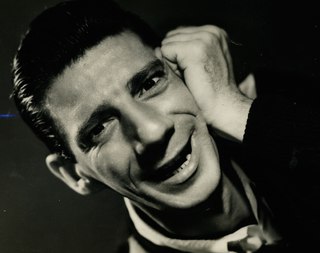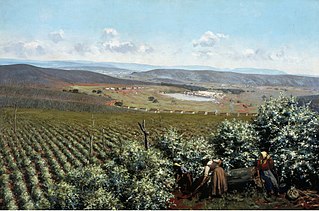Related Research Articles

Brazilian cinema was introduced early in the 20th century but took some time to consolidate itself as a popular form of entertainment. The film industry of Brazil has gone through periods of ups and downs, a reflection of its dependency on state funding and incentives.

The agriculture of Brazil is historically one of the principal bases of Brazil's economy. While its initial focus was on sugarcane, Brazil eventually became the world's largest exporter of coffee, soybeans, beef, and crop-based ethanol.

The São Paulo International Film Festival, also known internationally as Mostra, is an annual film festival held in the city of São Paulo, Brazil. A non-profit event, the festival is organized by ABMIC. The state and city of São Paulo have established October as the festival's official month.
O Trem da Morte is a 1924 Brazilian film directed by José del Picchia, and starring Olga Navarro. It was produced by Hélios Filme. It is a semidocumentary film, which use real scenes, of the Revolution of 1924—a lieutenant revolt in São Paulo.

The Cinemateca Brasileira is the institution responsible for preserving Brazilian audiovisual production. In July 2021, it experienced a major fire.

Eles Não Usam Black-tie is a 1981 Brazilian drama film directed by Leon Hirszman, based on Gianfrancesco Guarnieri's play of the same name.

Lauro Escorel Filho, most known as Lauro Escorel, is an American-born Brazilian cinematographer and film director. He was born during his father, a Ministry of External Relations, stay in Washington, DC. He first worked as an assistant to Dib Lutfi and Affonso Beato, and made his debut in 1971 on Leon Hirszman's São Bernardo, which won Gramado Film Festival Best Cinematography Award. He directed the short film Libertários, winner of Margarida de Prata Award from the National Conference of Bishops of Brazil, in 1976. In 1978, he would win again the Gramado Film Festival Best Cinematography Award for his work on Héctor Babenco's Lúcio Flávio, o Passageiro da Agonia. His first feature film, Sonho sem Fim, won the Jury Special Award at the 1986 Gramado Film Festival. Ironweed (1987), another Babenco's film, would make him more known internationally.

Events in the year 1948 in Brazil.

Helena Ignez is a Brazilian actress and filmmaker who participated in the Cinema Marginal movement during the 1960s and 70s alongside Rogério Sganzerla and Glauber Rocha.

The 2017 Brazilian general strike took place on April 28, 100 years after Brazil's first general strike in June 1917. The movement was a protest against reforms of labor laws, which were later adopted and social security proposed by Michel Temer government and pending in National Congress of Brazil.

Instituto Itaú Cultural is a Brazilian not-for-profit cultural institute owned by Itaú Unibanco. The institute was founded by Olavo Egydio Setúbal and created under the Law nº 7505, of 3 October 1986. The institute's goal is to map artistic manifestations and to foster artistic research and production related to all cultural sections.

The 2018 Brazil truck drivers' strike, also called the diesel crisis, was a strike of self-employed truck drivers that began on 21 May 2018.

1917–1919 Brazil strike movement was a Brazilian industry and commerce strike starting in July 1917 in São Paulo, during World War I, promoting by anarchist-inspired workers' organizations allied with the libertarian press. From 1917 to 1919, a large strike movement shook the First Brazilian Republic, concentrated in São Paulo and Rio de Janeiro. It culminated in several general strikes in 1917 and an attempted anarchist uprising in November 1918. The 1917 general strike is considered the first general strike in the labor history of Brazil, and marks the beginning of the period known as the five red years.

Lírio Mário da Costa, better known as Costinha, was a Brazilian comedian and actor.
Aruanda is a 1960 Brazilian documentary short film by Linduarte Noronha, about the remnants from a former quilombo in the backlands of Paraíba State.
Samba-choro is a subgenre of samba that emerged in Rio de Janeiro in early 1930s in Brazil. It was a syncopated hybrid fusion of samba with the Brazilian instrumental genre choro, but with medium tempo and presence of lyrics.

The Brazilian Workers' Confederation was the first national trade union center in Brazil, founded in 1908, under the basis of agreement of the First Brazilian Workers' Congress of 1906. Through its newspaper, A Voz do Trabalhador, it allowed a certain coordination and exchange of information within the Brazilian worker movement at the national level. The COB was formed by national industry and craft federations, local and state unions, unions isolated in places where there were no federations and non-federated industries.

In Brazil's economic history, the coffee cycle was a period in which coffee was the main export product of the Brazilian economy. It began in the mid-19th century and ended in 1930. The coffee cycle succeeded the gold cycle, which had come to an end after the exhaustion of the mines a few decades earlier, and put an end to the economic crisis generated by this decadence.

The 1978–1980 ABC Paulista strikes were a series of workers' protests that took place in the ABC Region of Brazil, in the context of the redemocratization of Brazil. The strikes marked a resurgence of the Brazilian labor movement after its repression by the military dictatorship between 1968 and 1972.
Museum of Images of the Unconscious was inaugurated on May 20, 1952, in the then National Psychiatric Center in the Engenho de Dentro neighborhood of Rio de Janeiro, initiated by psychiatrist Nise da Silveira. It houses approximately 350,000 artworks created by patients with mental disorders through the art therapy practiced by Dr. Nise.
References
- 1 2 "ABC da Greve" (in Portuguese). Base de Dados da Cinemateca Brasileira. Archived from the original on 9 January 2020. Retrieved 30 May 2020.
- 1 2 Salem, Helena (2004). "Leon Hirszman". Enciclopédia do Cinema Brasilero (in Portuguese) (2.ª ed.). São Paulo, Brasil: Senac. pp. 293–295. ISBN 85-7359-093-9.
- ↑ "ABC da Greve" (in Portuguese). Enciclopédia Itaú Cultural. Retrieved 30 May 2020.
- ↑ "ABC da Greve" (in Portuguese). TV Brasil. 11 October 2016. Retrieved 30 May 2020.
- ↑ "Retrospectiva Leon Hirszman exibe 'ABC da Greve'" [Leon Hirszman retrospective shows 'ABC da Greve'] (in Portuguese). Folha de S.Paulo. 9 March 1991. Retrieved 30 May 2020.